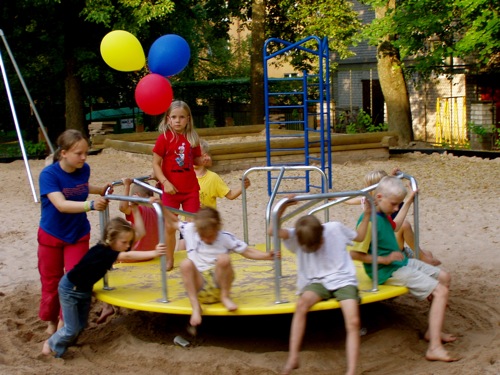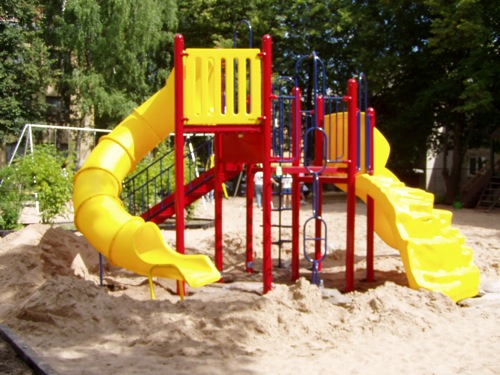• Evaluating Play Equipment

We are working on building a playground for some children in India. So we are partnering with Kids Around the World, who have successfully installed over 100 playgrounds worldwide now. In doing my homework about playgrounds, I ran across this excellent article by Anne-Marie Spencer, who has offered this helpful article on Evaluating Play Equipment. I liked it so much that I am hereby, preserving it for others to read and learn from on my blog. So here it is, in it’s entirety. (Photo from Estonia Playground)
Evaluating Play Equipment
By Anne-Marie Spencer“Play is an essential component in the development of children, affecting our physical, cognitive, emotional and social well being. As children play, they learn to define who they are and who they will become. Play is crucial for children; through their play experiences, they are able to improve overall physical fitness, build a variety of skills, work on problem solving, practice communication and set goals to reach. Through the achievement of those goals, they establish confidence and self-esteem. Play allows children the opportunity to interact with their peers, independent of adults, where they can share expectations, understand and appreciate their unique differences, and develop lasting friendship.
The need to play comes naturally to all children. It is, as any childhood development expert will say, “the child’s work.” So how do we, as adults, and the providers of play environments, assure that we are offering all that a child requires in a play environment?
Since the early 60s, when architect M. Paul Friedberg invented the concept of linked play, playground design has improved greatly over the old-style play areas consisting of lonely metal pieces of play equipment scattered throughout a play area. Today, composite play structures are designed to contain a wealth of different activities and to meet exacting standards of safety and compliance. However, just because you build a new play structure does not necessarily mean kids will find it exciting. All structures are not created equal, so it is important to note a variety of points that can assist you in creating an environment that children will find irresistible and will enrich their “work” of play.
Safety
We cannot address overall playground design without mentioning safety. Today’s responsible playground manufacturers design equipment to rigorous standards regarding safety, exit zones, compliance issues, head entrapments, pinch and crush zones, and falls from excessive height. Be sure to ask the manufacturer you are considering about their compliance standards and what certification processes their equipment goes through. Remember, safety involves the playground owners, too. Just like an automobile, it doesn’t matter how safe it built, it is a lifetime of proper maintenance/usage that ensures that built-in safety standards will last long after the playground is installed.
Design
So how do you go about evaluating the types of equipment available and incorporating them into a great play environment? Be sure to talk to your playground representative about how many children will be using the playground at one time and the expected ages of the players. It is recommended that you create play zones for children in the 2 to 5 age group separate from the area for 5 to 12 year olds. Children in these two age groups have distinctly different skills, play patterns and comfort zones, and they should be provided with play areas designed for their level.
Providing a variety of equipment at appropriate levels of challenge is also important. Offering several types of activities at different deck heights offers younger children the opportunity to climb, slide and develop skills that are appropriate to their stage of development, as well as a higher skill level to move up to once the easier skills are mastered. This helps ensure that the playground will keep them coming back for more.
For example, playgrounds designed with all activities at a 3-foot and 4-foot deck height will be boring to 10 year-olds, and, conversely, if all play opportunities at 7-foot and 8foot deck heights, 5 and 6 year-olds may be intimidated.
It’s also important to note that it is never necessary to design equipment at heights over 8 feet. Research conducted by preeminent childhood development expert Dr. Joe Frost has proven that children don’t experience a marked increase in height perception over 8 feet.
Therefore, exceeding this height only increases the risk of danger, not the fun.

(Photo from Estonia Playground)
Play Types
There are 12 recognized types of play:
1. Auditory/Sound (voice, listening, music) – Talk tubes, instruments
2. Balancing – Balance beams, mini pods
3. Brachiating (traveling hand to hand) – Overhead ladders, rings, track rides
4. Chinning – Chin-up bars and similar devices
5. Climbing – All types of climbing devices, rock walls
6. Gathering – Benches, seats, tables and leaning devices
7. Imaginative (nothing moves) – Tactile and visual panels, bubbles
8. Manipulative (something moves) – Game pieces, maze tables.
9. Rocking (springing, bouncing) – Spring riders, pogo poles, see-saws
10. Sliding – All types of slides
11. Spinning – Rotators, whirls, Xcelerator spinners and turning bars
12. Swinging –to/fro, rotating, and stand-in swings
Be sure your playground design incorporates as many of these types as space allows to ensure a play environment that encourages and develops a wide
range of skills and developmental opportunities. Remember, it isn’t always the number of play events that are on a play structure that make it a good value, itis the value of the play itself.
As an example, let’s look at hypothetical playground A vs. playground B. Playground A contains a 3-foot slide, 3-foot climber, 4-foot slide and eight activity panels for a total of 11 activities. Playground B has the same 3-foot slide and climber, but also a 5-foot slide and climber, a 6-foot slide and climber, a set of monkey bars, a spinning device, and two themed rock climbers. Although B only has 10 activities and costs $350 more, it is without question the better value. Why? Children have slides and climbers at three different deck heights (comfort/skill levels) on Playground B. It also has a motion-based device, one of the hottest activities in today’s playground, as well as themed climbers that allow for imaginative play. Although Playground A has more activities and costs less, eight of those activities are panels, and kids just don’t come to the playground to flip game pieces or play tic tac toe. See the difference?
Estimating Costs
The process of estimating the construction of a playground is similar to that of the construction of any environment. However, costs sometimes become more difficult to predict for playgrounds that are being built through volunteer labor using donated or at-cost materials. The cost of initial site work can be substantial and should be determined early in the design process. For projects that are to be developed through a standard construction process, the following formula may be useful. Cost of playground equipment (x) + Cost of installation (.30x) + Cost of surfacing (.12x) + Cost of design fees, grading, landscaping, and other expenses (.10x) = Total project cost or budget.
Many playground equipment manufacturers offer the option of a community build, in which volunteers within the community erect and assemble the play structure. These companies offer written materials and instructions on organizing a successful volunteer installation, and they can provide trained supervisors to oversee the work. This process may save up to 30 percent of the cost of the playground. As a final design note, be sure to consider benches as an overall addition to your play plan. Manufacturers make benches that complement the play equipment, and seating options give adults places to sit and observe the children at play, increasing the possibility for supervision. Seating options also contribute to the social aspects of the playground by providing opportunities for children to interact with adults.
Ultimately, great play environments are a result of careful planning, product selection and supervision/maintenance. ”
Source: Anne-Marie Spencer is the director of
marketing for Game Time, www.gametime.
com. She travels throughout the United
States giving lectures on the value of play.






Leave a Comment